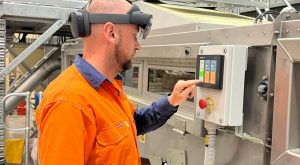HoloLens helps Graintech reduce carbon emissions

The Power of Microsoft HoloLens and Mixed Reality.
According to GRAINTECH CEO Nick Smith, ‘current estimates are that the world needs to produce 70 per cent more food to keep up with population growth by 2050. With the reduction in arable land, farmers must achieve higher yields from what they sow.’ The reliance on companies like GRAINTECH to do more with less and be as efficient as possible has never been more important. COVID shined a spotlight on how fragile the world’s supply chain is.
Like most individuals and businesses, Graintech reevaluated how they operated in 2020. One of the major alarming statistics that shocked them was how much they spent on travel and expenses. The hundreds and hundreds of thousands of dollars were one thing, but the huge carbon footprint left behind was eye-opening. As they look towards the future, they knew that reducing their carbon emissions was key to ensuring there is a tomorrow.
Their pre-COVID operating model involved sending a senior executive or subject matter expert (SME) on-site to install ‘a single machine, designing an entire greenfield site, or making a service call.’ Not only were the carbon emissions and travel expenses high, but the process was highly inefficient with significant downtime and bottlenecks throughout their operations. They recognized the power of Microsoft HoloLens and Mixed Reality and tapped into it to facilitate a remote operations model. The result was a 68% decrease in the amount of carbon emissions they produced.
Most of the tasks mentioned above could be done with remote support and guidance. They adopted key scenarios like remote inspections, diagnoses, service calls, and always-on and real-time support, to mention a few. For more details on how they achieved this, check out our past blog post about how companies reduce operating costs and carbon emissions with remote operations.
Another area of concern is the decreasing number of skilled workers and baby boomers retiring. Technology is rapidly growing and helps ease the issue of a declining workforce. However, skilled workers remain vital to a successful manufacturing business. In certain cases, technology remains on the back burner and cannot replicate the human touch. Technology does not solve the problem but helps companies like Graintech deploy their workforce in a more effective manner. Instead of sending a subject matter expert to inspect a piece of machinery for a couple of days, SMEs can work from a central location and virtually inspect machinery from multiple locations without all the wasted time of travel.


